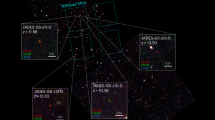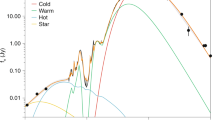Abstract
A significant fraction of the energy emitted in the early Universe came from very luminous galaxies that are largely hidden at optical wavelengths (because of interstellar dust grains); this energy now forms part of the cosmic background radiation at wavelengths near 1 mm (ref. 1). Some submillimetre (submm) galaxies have been resolved from the background radiation2, but they have been difficult to study because of instrumental limitations3. This has impeded the determination of their redshifts (z), which is a crucial element in understanding their nature and evolution4. Here we report spectroscopic redshifts for ten submm galaxies that were identified using high-resolution radio observations5,6,7. The median redshift for our sample is 2.4, with a quartile range of 1.9–2.8. This population therefore coexists with the peak activity of quasars, suggesting a close relationship between the growth of massive black holes and luminous dusty galaxies8. The space density of submm galaxies at redshifts over 2 is about 1,000 times greater than that of similarly luminous galaxies in the present-day Universe, so they represent an important component of star formation at high redshifts.
This is a preview of subscription content, access via your institution
Access options
Subscribe to this journal
Receive 51 print issues and online access
$199.00 per year
only $3.90 per issue
Buy this article
- Purchase on Springer Link
- Instant access to full article PDF
Prices may be subject to local taxes which are calculated during checkout


Similar content being viewed by others
References
Fixsen, D. J., Dwek, E., Mather, J. C., Bennett, C. L. & Shafer, R. A. The spectrum of the extragalactic far-infrared background from the COBE FIRAS observations. Astrophys. J. 508, 123–128 (1998)
Smail, I., Ivison, R. J. & Blain, A. W. A deep submillimeter survey of lensing clusters: a new window on galaxy formation and evolution. Astrophys. J. 490, L5–L8 (1997)
Smail, I., Ivison, R. J., Blain, A. W. & Kneib, J.-P. The nature of faint submillimetre-selected galaxies. Mon. Not. R. Astron. Soc. 331, 495–520 (2002)
Blain, A. W., Smail, I., Ivison, R. J. & Kneib, J.-P. The history of star-formation in dusty galaxies. Mon. Not. R. Astron. Soc. 302, 632–648 (1999)
Barger, A. J., Cowie, L. L. & Richards, E. A. Mapping the evolution of high-redshift dusty galaxies with submillimeter observations of a radio-selected sample. Astron. J. 119, 2092–2109 (2000)
Chapman, S. C., Richards, E. A., Lewis, G. F., Wilson, G. & Barger, A. J. The nature of the bright submillimeter galaxy population. Astrophys. J. 548, L147–L151 (2001)
Ivison, R. J. et al. Deep radio imaging of the SCUBA 8-mJy survey fields: submm source identifications and redshift distribution. Mon. Not. R. Astron. Soc. 337, 1–25 (2002)
Boyle, B. J. et al. The 2dF QSO redshift survey—I. The optical luminosity function of quasi-stellar objects. Mon. Not. R. Astron. Soc. 317, 1014–1022 (2000)
Cowie, L. L., Barger, A. J. & Kneib, J.-P. Faint submillimeter counts from deep 850 micron observations of the lensing clusters A370, A851, and A2390. Astron. J. 123, 2197–2205 (2002)
Ivison, R. J. et al. A hyperluminous galaxy at z = 2.8 found in a deep submillimetre survey. Mon. Not. R. Astron. Soc. 298, 583–593 (1998)
Barger, A. J. et al. Redshift distribution of the faint submillimeter galaxy population. Astron. J. 117, 2656–2665 (1999)
Ivison, R. J. et al. The diversity of SCUBA-selected galaxies. Mon. Not. R. Astron. Soc. 315, 209–221 (2000)
Richards, E. A. The nature of radio emission from distinct galaxies: The 1.4 GHz observations. Astrophys. J. 533, 611–630 (2000)
Fomalont, E. B., Kellermann, K. I., Partridge, R. B., Windhorst, R. A. & Richards, E. A. The microjansky sky at 8.4 GHz. Astron. J. 123, 2402–2416 (2002)
Barger, A. J. et al. Submillimetre-wavelength detection of dusty star-forming galaxies at high redshift. Nature 394, 248–251 (1998)
Chapman, S. C. et al. The properties of microjansky radio sources in the HDF-N, SSA13, and SSA22 fields. Astrophys. J. 585, 57–66 (2003)
Scott, S. E. et al. The SCUBA 8-mJy survey—I. Submillimetre maps, sources and number counts. Mon. Not. R. Astron. Soc. 331, 817–837 (2002)
Chapman, S. C., Lewis, G. F., Scott, D., Borys, C. & Richards, E. A. Understanding the nature of the optically faint radio sources and their connection to the submillimeter population. Astrophys. J. 570, 557–570 (2002)
Condon, J. Radio emission from ordinary galaxies. Annu. Rev. Astron. Astrophys. 30, 575–611 (1992)
Barger, A. J. et al. X-ray, optical and infrared imaging and spectral properties of the 1-Ms Chandra Deep Field North sources. Astron. J. 124, 1839–1885 (2002)
Steidel, C. C., Adelberger, K. L., Giavalisco, M., Dickinson, M. & Pettini, M. Lyman-break galaxies at z > 4 and the evolution of the ultraviolet luminosity density at high redshift. Astrophys. J. 519, 1–17 (1999)
Steidel, C. et al. The population of faint optically-selected AGN at z ∼3. Astrophys. J. (in the press); preprint available at http://www.arXiv.org/astro-ph/0205142 (2002)
Blain, A. W., Smail, I., Ivison, R. J., Kneib, J.-P. & Frayer, D. T. Submillimeter galaxies. Phys. Rep. 369, 111–196 (2002); preprint available at http://www.arXiv.org/astro-ph/0202228 (2002)
Kennicutt, R. C. Star formation in galaxies along the Hubble sequence. Annu. Rev. Astron. Astrophys. 36, 189–232 (1998)
Pettini, M. et al. The rest-frame optical spectra of Lyman-break galaxies: star formation, extinction, abundances and kinematics. Astrophys. J. 554, 981–1000 (2001)
Chapman, S. C., Smail, I., Ivison, R. & Blain, A. The effect of lensing on the identification of SCUBA galaxies. Mon. Not. R. Astron. Soc. 335, 17–21 (2002)
Sheinis, A. I. et al. ESI, a new Keck Observatory echellette spectrograph and imager. Publ. Astron. Soc. Pacif. 114, 851–865 (2002)
Oke, J. B. et al. The Keck low-resolution imaging spectrometer. Publ. Astron. Soc. Pacif. 107, 375–385 (1995)
Chapman, S. C., Helou, G., Lewis, G. F. & Dale, D. The bi-variate luminosity-colour distribution of IRAS galaxies, and implications for the high redshift Universe. Astrophys. J. (in the press); preprint available at http://www.arXiv.org/astro-ph/0301233 (2002)
Smail, I. et al. A vigorous starburst in the SCUBA galaxy N2_850.4. Mon. Nat. R. Astron. Soc. (in the press); preprint available at http://www.arXiv.org/astro-ph/0303128 (2003)
Acknowledgements
We thank C. Steidel, A. Shapley and T. Heckman for discussions. S.C.C. acknowledges support from NASA. I.R.S. acknowledges support from the Royal Society and a Philip Leverhulme Prize Fellowship. NRAO is operated by Associated Universities Inc., under a cooperative agreement with the US National Science Foundation. Data presented herein were obtained using the W. M. Keck Observatory, which is operated as a scientific partnership among Caltech, the University of California and NASA. The Observatory was made possible by the financial support of the W. M. Keck Foundation.
Author information
Authors and Affiliations
Corresponding author
Ethics declarations
Competing interests
The authors declare that they have no competing financial interests.
Rights and permissions
About this article
Cite this article
Chapman, S., Blain, A., Ivison, R. et al. A median redshift of 2.4 for galaxies bright at submillimetre wavelengths. Nature 422, 695–698 (2003). https://doi.org/10.1038/nature01540
Received:
Accepted:
Issue Date:
DOI: https://doi.org/10.1038/nature01540
This article is cited by
-
A cosmic growth spurt in an infant galaxy
Nature (2013)
-
A dust-obscured massive maximum-starburst galaxy at a redshift of 6.34
Nature (2013)
-
Intense star formation within resolved compact regions in a galaxy at z = 2.3
Nature (2010)
-
Hidden Universe uncovered
Nature (2009)
-
Redshift distribution of the submillimeter extragalactic background light
Astrophysics and Space Science (2008)
Comments
By submitting a comment you agree to abide by our Terms and Community Guidelines. If you find something abusive or that does not comply with our terms or guidelines please flag it as inappropriate.



